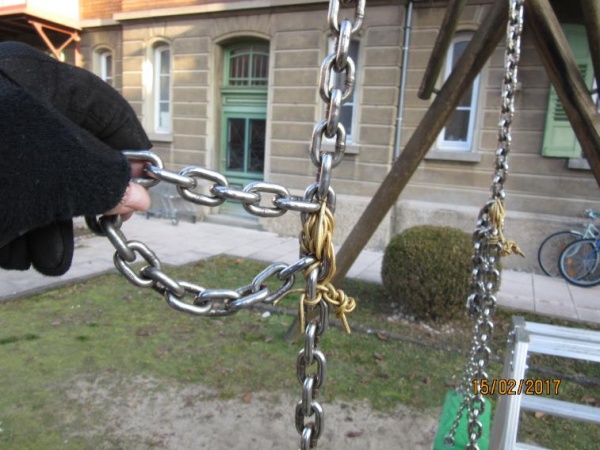Tell me, mum, who is actually allowed to control playgrounds?
If we looked on the Internet at "www.frag-mutti.de", we would probably not get ....


YOUR FORUM FOR PLAY, SPORTS UND LEISURE AREAS

There is no safer place than a children's playground! A bold assertion or reality?
Let's start in the 1980s. Back then, Germany became the first country to draw up a standard for playground equipment. The reason was simple: the number of accidents was too high for society and so playground manufacturers got together to establish minimum safety requirements. There were general requirements for all equipment and specific requirements for equipment which set children in motion. These minimum requirements resulted in a sharp fall in the number of accidents.
Experience with materials, technical innovations and accident analyses were all reflected in the DIN 7926 standard. And behind each measure was a corresponding protection goal.
For example: Phalanges were constantly being torn off by long-linked chains. This was the reason for the call for the use of short-linked chains! And since this change I have not been made aware of a single case of a phalanx being torn off.
In the EU
Other EU countries used this German standard as a common thread to remove trade barriers as well as to make construction safer. As a result a European standard was developed with minimum requirements for the manufacture of playground equipment. The goal was to ensure that all equipment traded within Europe met the same safety standards.
Other physical dimensions, accident incidences, etc. also contributed to a significant expansion of the formerly German standard into the EN 1176: 1998 standard, published in seven parts. With part seven suddenly woven in!
A part seven concerning installation, inspection, maintenance and operation had not existed hitherto as the standard had been drawn up for manufacturers of playgrounds. Now manufacturers had a guideline for dealing with equipment, from construction through operation to disposal.
So why was part 7 added? Because the operators of playgrounds were demanding instructions from manufacturers in order to maintain technical equipment at the required safety level. Let's take the example of our car. Regular maintenance and inspections by the operator maintain roadworthiness and the desired safety level.
In short, part seven obliged manufacturers to issue maintenance instructions because only manufacturers know the quality of the materials that they use. For example, steel cable quality, the durability class of timbers, the wall thickness of steel pipes, etc...
Examples
The introduction of the EN standard means the manufacturers of playground equipment are required to provide operators, which bring this equipment into service, with instructions.
These maintenance instructions are the most important element in ensuring that the required safety level is maintained. So the item of playground equipment is expected to be kept in virtually its original condition by means of specialist maintenance.
Let us consider a common maintenance fault. It was a fault which resulted in one man almost having his finger torn off. In attempting to provide assistance this individual caught a ring on his finger and tore its tendons and sanguiferous vessels.
A protruding thread on wooden equipment usually occurs after a long, dry period during which the woods shrinks and the nut does not cover the protruding thread again completely when tightened. Now a protective cap generally no longer fits and the protrusion can be dangerous.
Part seven providing guidance for inspection has also opened up a new business field for the specialist playground inspector and, in the last few years, the qualified playground inspector in accordance with the DIN 79161 standard.
This inspector, who verifies compliance with standards, is almost unique to the playground equipment / playground field. Or have you ever purchased the corresponding standard when you have bought a children's bicycle or lawnmower, for example, to ensure that the manufacturer / operator has complied with the safety requirements? There are various reasons for the never-ending quest to improve safety, with a fresh spectre always hot on the heels of the previous one: from "contact corrosion" to the "wood splinter". New supposed danger points are constantly being contrived or found. Lawyers are called into action with constant newly-fomented anxieties.
And a further complication are the perpetual, seemingly never-ending changes to the rules of technology of the German Institute for Standardization. Let us take the DIN EN standards, drawn up in full in 1998, amended in 2003 and reworked again in 2008. This is also what the statutes of the German Institute for Standardization provide for! A review every five years and a reworking every ten years.
Only critical new accident incidences justify an earlier new version of a standard.
The 2017 standard with several parts that are still incomplete, not to mention the content, does not simplify matters.
To open up fewer interpretation possibilities for trainers of playground inspectors and playground inspectors themselves, I think it is more important to communicate the protection goals.
Summary
So what kind of accidents occur on playgrounds? How many accidents are reported annually to the Municipal Insurance Association (GVV)?
In the Saarland, Rheinland-Pfalz and Hessen insurance area, with a population of around 10 million, between 30 and 50 accidents on playgrounds are reported per year. And in the last ten years this has not included a single serious accident! Source: GVV
Which, returning to our original question, means that there is nowhere safer than a playground!
And thanks to the professionalism of planners, manufacturers and operators there will also be very, very few serious accidents in the future attributable to poor planning or construction of playground equipment and playgrounds.
In my 15 years as a publicly appointed and sworn expert there have rarely been more than three expert opinions requested. This figure also reflects the low number of accidents.